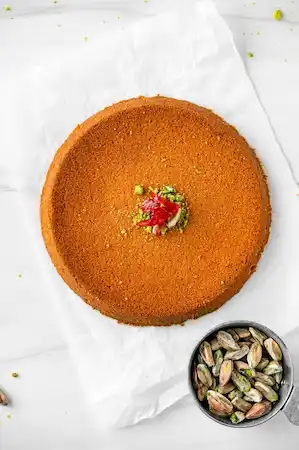Kunafa, or kataifi as it’s called in Greece, is one of the world’s most popular Arabic desserts, alongside Baklava and Basbousa. But what exactly is Kunafa? How many different types of Kunafa are there? And what are its health benefits? This article will answer these questions and more.
What is Kunafa?
Kunafa is a traditional Arabic dessert made with shredded phyllo dough, cheese, and syrup. It is popular in many Arab countries and has several different regional variations. The dish is made with cheese and shredded phyllo dough and can be served sweet or savory. You can find variations from country to country, with Syrian Kunafa being an example of one kind.
The Main Types of Kunafa you need to know about
The dough used in Kunafa can vary depending on the region. Still, the most common types are semolina, shredded wheat, or phyllo dough.
There are primarily 7 different types of Kunafa:
- Cheese Kunafa
- Raw unripe apricot Kunafa
- Coconut Kunafa
- Kunafa Khishneh
- Kunafa Naameh
- Kunafa Mabroomeh
- Kunafa Bayn Narain
Here is more detail about each of these types.
Cheese Kunafa
One of the most popular types of Kunafa is the Cheese Kunafa, which is made with shredded cheese and semolina dough. It is often served with sweet syrup or honey. The Lebanese variation uses walnuts and crushed almonds, while Iraqi versions include powdered sugar.
Raw unripe apricot Kunafa
Another common type of Kunafa is raw unripe apricot Kunafa, which includes green almonds. In this version, the filling consists mainly of ground unsalted pistachios, cream cheese, flour, milk, sugar, and green apricots that have not yet ripened enough to become soft and moist when eaten.
Coconut Kunafa
Kunafa can also be prepared using coconut as its main ingredient instead of dough. You can take a package of ladyfingers and cut them into small pieces; mix these up with shredded coconut, confectioner’s sugar, lemon juice, and vanilla extract; pour some melted butter over the mixture; cover it up with aluminum foil and bake for 20 minutes at 350 degrees Fahrenheit (175 degrees Celsius).
Kunafa Khishneh
Kunafa Khishneh is one of the most popular types of Kunafa and is made with semolina dough that is soaked in syrup and then filled with shredded cheese. It is then baked until the cheese is melted and the dough is golden brown.
Kunafa Naameh
Kunafa Naameh is the traditional Kunafa, made with delicate noodle-like pastry. It is often made with Akkawi, a slightly salty white cheese. The cheese is melted and spread over the Kunafa dough, which is then formed into coils and baked. Once it is out of the oven, it is soaked in syrup and served warm.
Kunafa Mabroomeh
These Kunafa are made with thin sheets of phyllo dough rolled up and filled with a sweet cheese filling. They are then fried until golden brown and served with simple syrup.
Kunafa Bayn Narain
Kunafa Bayn Narain is a type of Kunafa made with shredded wheat and cheese. It is one of the most popular Kunafa in the Arab world. It is usually served with sweet syrup or honey. The texture of this Kunafa may be soft, chewy, or crunchy, depending on how it is prepared.
Which type of Kunafah is best?
There are many different types of Kunafa, but the two most popular are probably Akkawi and Atayef. Akkawi is made with fresh cheese and has a light, fluffy texture. Atayef, on the other hand, is made with ricotta cheese and has a denser, more cake-like texture. So which is better? Well, it all comes down to personal preference. If you like your Kunafa light and airy, go for Akkawi.
General Health Benefits of Kunafa
Kunafa is loaded with antioxidants, which can help protect your cells from damage and may promote a healthy immune system. It is also a good source of fiber, which can help keep you regular and may promote heart health by helping to lower cholesterol levels.
Kunafa contains iron, essential for making hemoglobin, the protein that carries oxygen in your blood. It is rich in calcium, essential for strong bones and teeth.
Its slow-digesting carbohydrates help reduce blood sugar levels while the Kunafa which is made with cheese and nuts is an excellent protein source.
Kunafa has many more calories than other desserts. Still, it also has fewer calories than many types of bread or other grain products such as pasta or rice. It is low in fat, especially compared to fattening desserts like ice cream or chocolate cake!
I am Anand, and I am a business owner and consultant in my day job. I have spent years studying what’s inside the products we buy. ‘Feedrer’ is a wordplay on you-know-who and talks about all things food.
